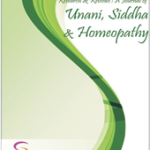
Neha Patel,
- Associate Professor Department of Case taking and Repertory, Smt. C.M.P. Homeopathic Medical College, Mumbai Maharashtra India
Abstract
Heloma (Corn), is a horny induration and thickening of the stratum corneum resulting from faulty mechanics, irregular distribution of pressure, bony prominences and repetitive motion injury due to repetitive activities or problems with footwear. Thus, both the extrinsic factor and the intrinsic factor are responsible for the formation of Heloma (Corn) affecting 14-18% of people. As most people consider it as a non-threatening condition, they seek home remedial measures like pedicures or cutting of the Heloma (Corn) which can cause injuries or complications (bacterial/fungal infection). The treatment of Heloma (Corn) are invasive with high recurrence rate, at times there is scarring after these treatment which inturn leads to formation of Heloma (Corn). This these treatment have low efficacy and need longer recovery period and at times immobilisation which can be for 4 to 6 weeks. As this condition is caused by the interplay of extrinsic factor and intrinsic factor, an individualized treatment must be considered for such a problem. Homoeopathic treatment deals with a holistic individualized approach where each patient suffering from Heloma (Corn) is not given the same remedy. Homeopathy offers noninvasive, cost-effective long-term remedies which are simple to administer, they have no side effects, will not result in scarring and will not require immobilization. Hence, this study lists the common type, location and cause of Heloma (Corn) and shows efficacy of homoeopathy in the treatment of Heloma (Corn) as demonstrated by the changes in the Number/Diameter of Heloma (Corn), Pain intensity using The Visual Analogue Scale (VAS) and Quality of life of patients having Heloma (Corn) using EQ-5D 5L.
Keywords: Heloma (Corn), Intrinsic factor, Extrinsic factor, Homeopathy
References
- Farndon L, Vernon DW, Parry A. What is the evidence for the continuation of core podiatry services in the NHS: A review of foot surveys. Br J Podiatry. 2006;9:89–94.
- Bennett PJ, Patterson C, Wearing S, Baglioni T. Development and validation of a questionnaire designed to measure foot-health status. J Am Podiatr Med Assoc. 1998;88:419–27.
- Arndt KA, Hsu JT. Manual of Dermatologic Therapeutics. 7th ed. Philadelphia; Lippincott Williams and Wilkins; 2007. p. 47.
- Takehara K, Oe M, Ohashi Y, Tsunemi Y, Kadowaki T, Sanada H. Differences between patient-reported versus clinician-observed nonulcerative signs and symptoms of the foot in patients with diabetes mellitus. J Wound Ostomy Continence Nurs. 2019;46:1136-6.
- Rodríguez-Sanz D, Tovaruela-Carrión N, López-López D, Palomo-López P, Romero-Morales C, Navarro-Flores E, et al. Foot disorders in the elderly: A mini-review. Dis Mon. 2018;64:64-91.
- Arndt KA, Hsu JT. Manual of Dermatologic Therapeutics. 7th ed. Philadelphia; Lippincott Williams and Wilkins; 2007. p. 47
- Springett K. The influence of forces generated during gait on the clinical appearance and physical properties of skin callus. PhD. University of Brighton: Podiatry; 1993.
- Richard RN. Calluses, corn and shoe, Semin Dermatology 1991;10:112-4.
- Singh D, Bentley G, Trevino SG. Callosities, corns, and calluses. BMJ. 1996 Jun 1;312(7043):1403-6. doi: 10.1136/bmj.312.7043.1403a.
- Uday Khopkar, Skin Diseases and Sexually Transmitted Infections, 7th edition, 2018.
- Haneke E. Differential diagnosis and therapy of calluses, corns and plantar warts (author’s transl) Z Hautkr 1982;57:263-72.
- El-Mohamady Ael-S, Mearag I, El-Khalawany M, Elshahed A, Shokeir H, Mahmoud A. Pulsed dye laser versus Nd: YAG laser in the treatment of plantar warts: A comparative study. Lasers Med Sci 2014;29:1111-6.
- Al Aboud AM, Yarrarapu SN. Corns Treasure Island (FL): StatPearls Publishing; 2022.
- Scott, J. and E. Huskisson, Graphic representation of pain. Pain, 1976. 2(2): p. 175-184.
- The EuroQol Group. EuroQol-a new facility for the measurement of healthrelated quality of life. Health Policy. 1990;16:199–2.
- Williams ML, Elias PM. Enlightened therapy of the disorders of cornification. Clin Dermatol. 2003 Jul-Aug;21(4):269-73. doi: 10.1016/s0738-081x(03)00059-2.
- DeLauro TM, DeLauro NM, Corns and Calluses. In: Goldsmith LA, Katz SI, Gilchrest BA, Paller AS, Leffell DJ, eds. Fitzpatrick’s Dermatology in General Medicine, 7th edition New York. The McGraw-Hill Companies; 2008.
- Snider, Robert K, Essentials of Musculoskeletal Care, Corns and Calluses, Amer Academy of Orthopaedic, January 1997.
- Menz HB, Morris ME. Footwear characteristics and foot problems in older people. Gerontology. 2005 Sep-Oct;51(5):346-51. doi: 10.1159/000086373.
- Dunn JE, Link CL, Felson DT, Crincoli MG, Keysor JJ, McKinlay JB. Prevalence of foot and ankle conditions in a multiethnic community sample of older adults. Am J Epidemiol. 2004 Mar 1;159(5):491-8. doi: 10.1093/aje/kwh071.

Research & Reviews : A Journal of Unani, Siddha and Homeopathy
| Volume | |
| Received | July 29, 2024 |
| Accepted | July 31, 2024 |
| Published | August 7, 2024 |

